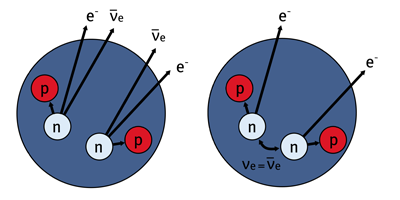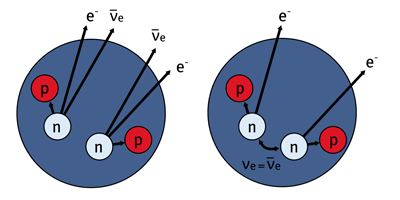Neutrinoless Decays Are a No Show Again
The neutrino could be its own antiparticle, and this dual role could cause neutrinos to disappear from certain nuclear decays. Tentative evidence for neutrinoless decays appeared in 2004, in conflict with other experimental searches. A new experiment called Gerda has now conclusively refuted this positive result. The nondetection, reported in Physical Review Letters, places the most stringent limits yet on how frequently neutrinoless decays could occur.
Saying that neutrinos and antineutrinos have the same identity (as described by Ettore Majorana in 1932) conflicts with the standard model of particle physics, but it might explain why neutrinos have a much smaller mass than other particles. One way to test for the neutrino’s true nature is with double beta decay, in which two neutrons decay simultaneously into a pair of protons, electrons, and antineutrinos. In the Majorana picture, the same reaction could occur with an antineutrino emitted by one neutron being absorbed as a neutrino by a second neutron. In this neutrinoless double beta decay, the electrons would carry away all the emitted energy.
The Germanium Detector Array (or Gerda), located in the INFN Gran Sasso National Laboratory in Italy, reproduces the earlier 2004 experiment but with improved background suppression. The researchers indirectly detect neutrinos from the double beta decay of germanium- by measuring the energy spectrum of the emitted electrons. Neutrinoless decays would cause a peak in the number of events at the maximum electron energy. The Gerda collaboration (Agostini et al.) found no such peak in their data, which implies the rate of neutrinoless double beta decay—if it occurs at all—is less than that of normal double beta decay. – Michael Schirber





